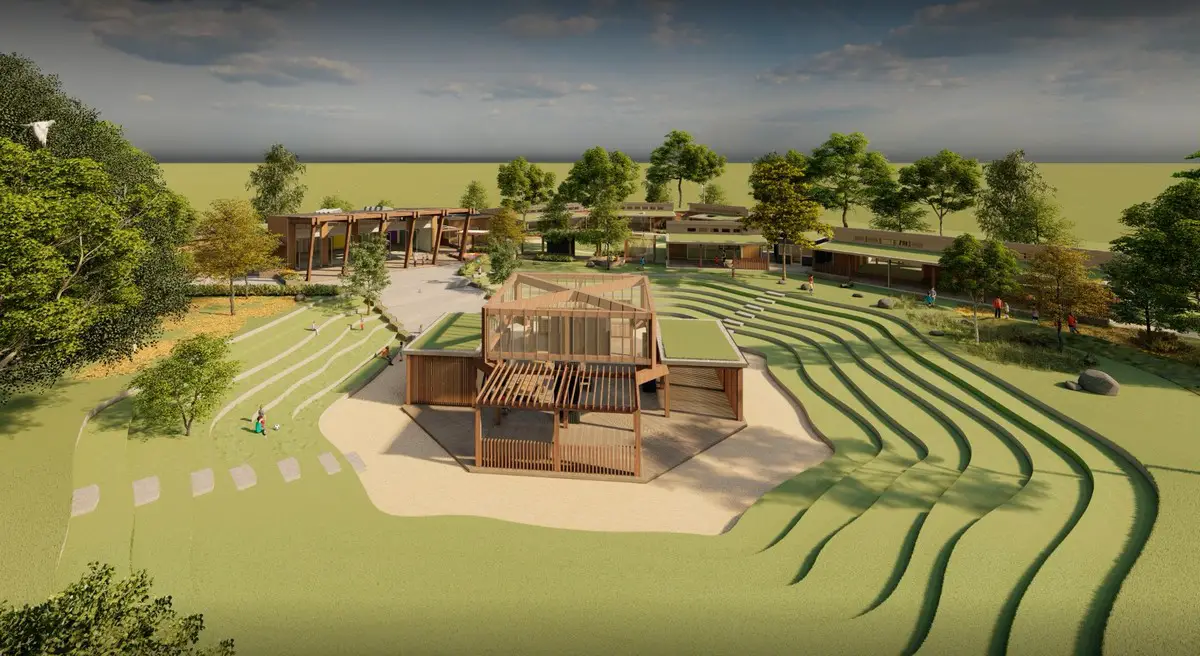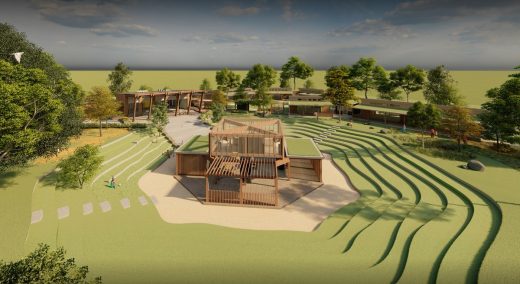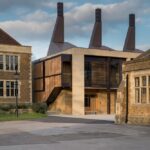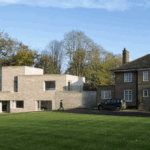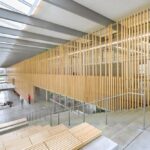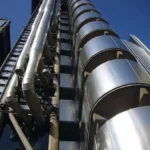Primary school of the future, English education building image, England biophilic architecture, UK Net-Zero property
Primary school of the future
post updated 7 March 2025
Education building designers TG Escapes https://www.tgescapes.co.uk, have shared their concept primary school of the future at Education Estates®, an annual gathering of the education community, in partnership with the Department for Education.
The design shows a Net-Zero, Biophilic, single-entry nursery and primary concept school to accommodate 300 children aged 0-11, for a building cost of £4m.
18 November 2022
Primary school of the future design
Designed with the outdoors in mind
The design utilises separate pavilions for various functions, connected by covered walkways and canopies, arranged to envelop a central landscaped, terraced area with an outdoor class at its centre. Walkways replace much redundant internal circulation with time outdoors, supporting various measures such as seating, outdoor play and learning facilities, and sedum roofs.
Mark Brown, consultant at TG Escapes, comments:
“It is a completely biophilic environment providing outdoor learning for the majority of the curriculum. Bright, airy buildings provide joyful spaces with high ceilings, exposed timber and abundant glazing for natural ventilation and light. Clad in natural timber they feature large solar PV arrays for sustainable net-zero operation. Biodiversity is a priority with bird and bat boxes, insect-supporting structures, natural living roofs, rainwater capture and ongoing tree planting.”
Net-zero in operation and lifetime
Constructed almost entirely from timber, utilising Modern Methods of Construction (MMC) to provide a low-cost, rapidly erected, high-performance, durable, low embodied carbon and net-zero operation school that is affordable to build, maintain and run in comparison to alternative building types. The layout, landscaping and design is considered to create a stimulating, wholesome and healthy environment. The carbon calculation shows that Whole Life Carbon (WLC) will be 201kgCO2e/m2 which comes well within the RIBA 2030 target.
In addition, this form of construction can encourage environmental citizenship among students. As they see a timber building rising it helps them to understand the principles of sustainable construction. This school can be built in stages to accommodate the cohorts as they move through the key stages. This will mean they see each additional building stage as it is developed and it’s possible because the modular construction process can be self-contained and kept safe which maintains education continuity everywhere else in the setting.
Why is there a need for biophilic design in schools?
Young people face the perfect storm; Covid, social media and other screen time, a rigid education system structured around exams and targets, a potential mental health crisis and their future skill requirements can be unknown. A biophilic environment is proven by many studies to help support these developmental needs.
Whole Life Carbon
Building: 198 tCO2e
Solar PV: 260 tCO2e
Sedum: 5 tCO2e
Total: 463 tCO2e
Estimated grid operational carbon saving: -338 tCO2e
Whole Life Carbon: 281 tCO2e = 201kgCO2e/m2
This exceeds the RIBA 2030 target for schools.
Duncan MurphyDirector of Education, MTM Consulting, adds:
“I am delighted to be involved in bringing TG Escapes’ vision of a biophilic school from concept to reality. Never has there been a more apposite time to marry the themes of sustainability and social mobility and embed them into a 21st century brand of education.”
A recent TG Escapes building case study: https://www.tgescapes.co.uk/sen-classroom-block-at-hundred-of-hoo-academy
The Benefits of Biophilic Design in Schools:
Film on YouTube
Background
Research amongst children by Dr Rokhshid Ghaziani from the School of Architecture at the University of Portsmouth:
https://www.tgescapes.co.uk/wp-content/uploads/2022/10/Education-Estates-Conference-Biophilic-School-Design-R-Ghaziani-Oct.-19th-2022.pdf
Costing analysis based on our turnkey sectional modular system (MMC Cat 2)
EBDOG benchmark survey for primary:
Average area per pupil – 5.69 m2
For the average 1984m2 = £2,224 pm2
BUT they add +10-15% for net zero = £2,500 pm2
TG Escapes Biophilic Concept School
Total cost to build accommodation excluding landscaping – £4m
Average area per pupil including circulation– 7.31 m2
Total area 2193 m2 = £1,823 pm2
UK primary school of the future biophilic building images / informatio received 171122
+++
Biophilic Buildings
Biophilic Building Designs
Merging architecture with nature in biophilic design
Biophilic design at Heriot Watt campus Dubai
Milan biophilic office of the future
MITOSIS Biophilic Regenerative Ecosystem
Biophilic Office Project at BRE, Watford
+++
English School Building Designs
English Education Architecture – recent selection on e-architect:
The Mitchell Building at Skinners’ School, Tunbridge Wells, Kent, south east England
Design: Bell Phillips Architects
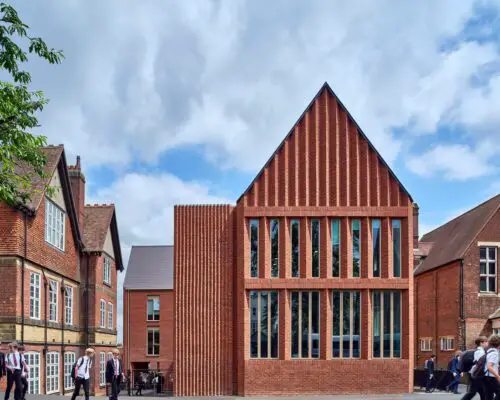
photo : Kilian O’ Sullivan
The Mitchell Building at Skinners’ School, Kent
Brentwood Preparatory School, Essex
Design: Cottrell & Vermeulen Architecture
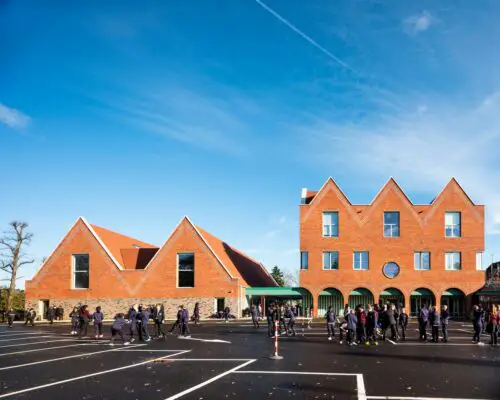
photo : Anthony Coleman
Brentwood Preparatory School Building, Essex
Charterhouse Science & Mathematics Centre, Godalming
Architects: Design Engine
Charterhouse Science & Mathematics Centre in Godalming
Mill Chase Academy Secondary School Building, Bordon, Hampshire
Design: HCC (Hampshire County Council) Architects
Mill Chase Academy Secondary School Building
Design Technology & Engineering Building at Stowe School, Buckinghamshire, south east England
Architects: Design Engine
Stowe School in Buckinghamshire
Civitas Academy, Reading, Berkshire
Design: HCC (Hampshire County Council) Architects
Civitas Academy Building
Art and Design Building, Bedales School, Steep, near Petersfield, Hampshire
Design: Feilden Clegg Bradley Studios
Art and Design Building, Bedales School
Holy Cross Primary School Building, Swindon, Wiltshire, Southwest England
Design: Cullinan Studio architects
Holy Cross Primary School, Swindon Building
More Modern English School Buildings Designs welcome.
Location: England, UK
+++
Architecture in England
+++
English School Buildings Links
Somerset College of Arts and Technology
Oxford Cherwell Valley College
Additions / photos for the Primary school of the future: biophilic building page welcome

